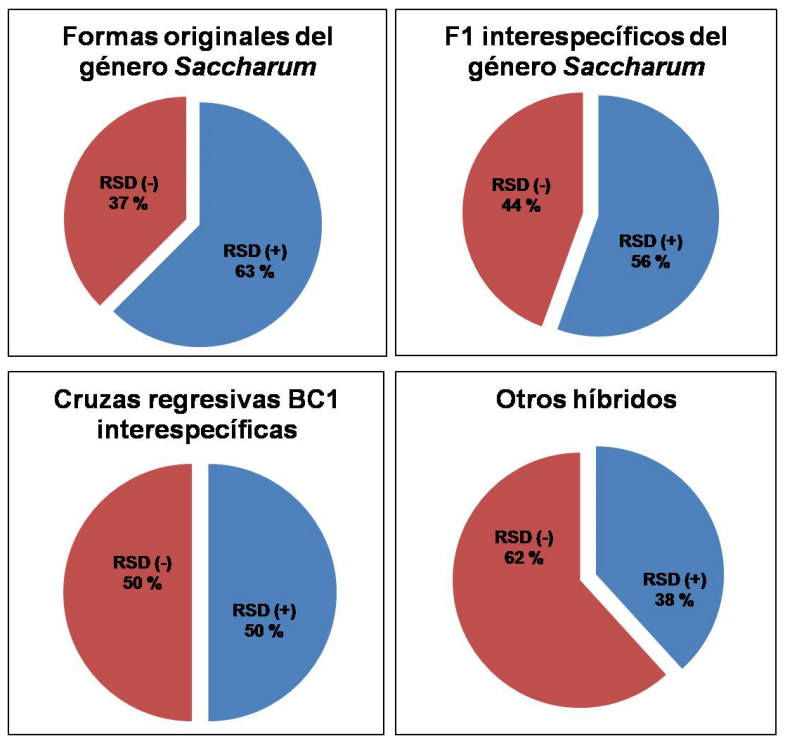Detection of Leifsonia xyli subsp. xyli in Sugarcane Germplasm under Natural Conditions
Main Article Content
Abstract
Rattoon stunted disease (Leifsonia xyli subsp. xyli (Davis) Evtushenko) is among sugarcane diseases mostly diffused worldwide, causing substantial losses in the crop. This work presents results of a study of the bacteria propagation in the sugarcane Germplasm Collection in Cuba. Different generational levels of forms and hybrids of individuals with more than 10 months of age were selected at random. From them a cylinder of stem was taken from a section close to the band of roots of the first internode. The samples were submitted to polymerase chain reaction (PCR). A total of 69 individuals was studied (24 original forms of gender Saccharum; 9 interspecific F1 of Saccharum; 2 regressive interspecific BC1 crosses and 34 of another hybrids) detecting the bacterium in 50% of them and in 63% of the original forms of Saccharum gender studied. The possibility exists of finding resistance sources present in those where no detection of the disease was observed, and for this reason suitable to enter in the Sugarcane Breeding Program in Cuba, although other inheritance and combinatory skills studies are required for this character in the progenitors.
Article Details

This work is licensed under a Creative Commons Attribution-NonCommercial 4.0 International License.
References
Chinea, A., Pérez, G., Chinea, A., Cabrera, L., Cruz, R., Pérez, J., & Pérez, Y. (2012). Resistencia natural del germoplasma de la caña de azúcar a enfermedades comunes en Cuba. Memorias del evento: Jornada Científico Productiva por el por el 65 Aniversario de la Estación Provincial de Investigaciones de la Caña de Azúcar “Antonio Mesa”. Jovellanos, Matanzas, Cuba, 15 de noviembre de 2012, 65.
Delgado-Padrón, J., Pérez-Pérez, J. de las M., Aday-Díaz, O. de la C., Casas-González, M., Casero-Rodríguez, T., Pardo-Mora, L., La O, M., & Hechavarría, M. (2018). Distribución del raquitismo de los retoños (Leifsonia xyli subsp. Xyli) en caña de azúcar en Cuba. Revista de Protección Vegetal, 33(1), 1-8.
Kazeem, S. A., & Ikotun, B. (2019). Effect of Leifsonia xyli subsp. Xyli on growth and yield of sugarcane in Nigeria. Journal of Plant Pathology, 101(3), 587-595.
Kazeem, S. A., Ikotun, B., Awosusi, O. O., Wintola, A. P., & Wada, A. C. (2015). Status of ratoon stunting disease of sugarcane (Leifsonia xyli subsp. Xyli) in Nigeria. Tropical Plant Pathology, 40(5), 350-354.
Lemma, A., Tafesse, A., & Tekle, A. (2015). Status of ratton stunting disease (Lefisonia xyli subsp xyli) in the initial seed cane and seed cane fields of Wonji Sugar factory. Global Science Research Journals. ISSN, 3(2), 213-217.
Mutonyi, J., & Nyongesa, H. (2016). Incidence and prevalence of ratoon stunting disease (Leifsonia xyli subsp. Xyli, Evtushenko) in the mumias sugar cane growing zone Kenya. IOSR Journal of Agriculture and Veterinary Science (IOSR-JAVS), 9(11), 28-31.
Oropeza, M., & Alonso, G. (2016). Leifsonia xyli subsp. Xyli, patógeno de la caña de azúcar en Venezuela: Agente causal del raquitismo de los retoños de la caña de azúcar. Editorial Académica Española, Madrid, España.
Pan, Y.-B., Grisham, M. P., Burner, D. M., Damann Jr, K. E., & Wei, Q. (1998). A polymerase chain reaction protocol for the detection of Clavibacter xyli subsp. Xyli, the causal bacterium of sugarcane ratoon stunting disease. Plant disease, 82(3), 285-290.
Pérez, J. R., & López, M. (1983). Importancia del raquitismo de los retoños (RSD) de la caña de azúcar. Ciencias de la Agricultura, 17, 3-12.
Pérez, J. R., Pérez, Y., Leyva, Y., Pérez, Y., & Pellón, Y. (2020). Afectación del rendimiento en cultivares infectados por raquitismo de los retoños (RSD) de la caña de azúcar en Cuba. Revista Cuba & Caña, 23(2), 20-24.
Roach, B. (1992). Susceptibility to ratoon stunting disease in the Saccharum complex and feasibility of breeding for resistance. Sugar Cane, 3, 1-11.
Rodríguez, M., Rodríguez, E., Alfonso, I., & Fuentes, A. (2014). Enfermedades y plagas. En Instructivo técnico para el manejo de la caña de azúcar. INICA, La Habana, Cuba.
Santana, I., González, M., Crespo, R., & Guillen, S. (2014). Enfermedades y plagas. Instructivo técnico para el manejo de la caña de azúcar. INICA, La Habana, Cuba.
Singh, D., Kaur, S., & Singh, J. (2020). Package of Practices for the Crops of Punjab Kharif 2020. Punjab Agricultural University Ludhiana, 37(1), 1-169.
Taher-Khani, K. (2010). Bases metodológicas para el manejo integrado del raquitismo de los retoños de la cana de azúcar en Irán [Tesis Doctoral. INICA-Sugarcane and By-Products Development Co. (Tesis en opción al grado científico de Doctor en Ciencias Agrícolas)]. Universidad Central de las Villas (UCLV), Santa Clara, Villa Clara, Cuba.
Yulianti, T., & Wijayanti, K. S. (2020). Management of ratoon stunting disease by hot water treatment to provide healthy cane seed. 418(1), 1-7.
Yulianti, T., Wijayanti, K., & Supriyono, S. (2019). Management of ratoon stunting disease by hot water treatment to provide healthy cane seed. 418, 20pp.
